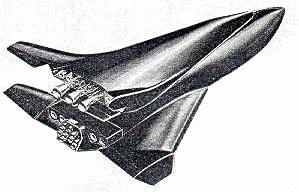
Home - Search - Browse - Alphabetic Index: 0- 1- 2- 3- 4- 5- 6- 7- 8- 9
A- B- C- D- E- F- G- H- I- J- K- L- M- N- O- P- Q- R- S- T- U- V- W- X- Y- Z
Shuttle LS A
 Shuttle LS A Credit: NASA |
Status: Study 1969. Thrust: 28,463.70 kN (6,398,894 lbf). Gross mass: 1,632,012 kg (3,597,970 lb). Height: 80.00 m (262.00 ft). Diameter: 10.00 m (32.00 ft).
Lockheed's $0.15-million shuttle Phase-A contract with NASA's Marshall Space Flight Center concentrated on fully reusable versions of the Starclipper after NASA rejected all partially reusable concepts in August 1969. The final design consisted of a delta-planform lifting-body orbiter and a body-wing first stage booster. Lockheed also considered a "triamese" configuration of its lifting body design, but ultimately rejected the approach since the booster/orbiter propellant crossfeed system only produced a marginal performance advantage while introducing additional complexity and operational risk into the design. The orbiter's large wingtip fins were expect to increase the vehicle's subsonic lift-to-drag ratio and provide increased stability over the entire speed range. An additional plus was the lifting-body delta-wing concept would meet Air Force cross range requirements. Lockheed recommended a 22,680kg payload capability although a smaller 11,340-kg version also was investigated. Another important Lockheed contribution was a new thermal protection system made of silica fiber "tiles" which provided better insulation than metallic "shingles" and Lockheed therefore proposed to build the basic structure of aluminum rather than titanium. The final Space Shuttle design would use this approach and by the end of 1969, all Phase-A contractors except General Dynamics were proposing a silica-tile based TPS. The Lockheed Phase-A shuttle would have cost $5.51 billion (=$25B at 1999 rates) to develop. This cost included five booster/orbiter pairs for 175 horizontal and 25 vertical flights. Two boosters+orbiters would have been transformed into operational vehicles and Lockheed would have built five additional orbiters & two boosters for the fleet. The cost per flight would have been $1.255 million ($5.7M in 1999 $'s), and the inflation-adjusted transportation cost per kilogram was to be $251/kg over 1000 flights including R&D amortization.
Stage Data - Shuttle LS A
- Stage 1. 1 x Shuttle LS A-1. Gross Mass: 1,225,668 kg (2,702,135 lb). Empty Mass: 162,494 kg (358,237 lb). Thrust (vac): 26,076.588 kN (5,862,250 lbf). Isp: 442 sec. Burn time: 754 sec. Isp(sl): 392 sec. Diameter: 10.00 m (32.00 ft). Span: 31.40 m (103.00 ft). Length: 67.07 m (220.04 ft). Propellants: Lox/LH2. No Engines: 13. Engine: SSME Study. Status: Study 1969 December. Comments: Delta winged configuration.
- Stage 2. 1 x Shuttle LS A-2. Gross Mass: 406,344 kg (895,835 lb). Empty Mass: 104,891 kg (231,245 lb). Thrust (vac): 6,823.560 kN (1,533,997 lbf). Isp: 459 sec. Burn time: 196 sec. Isp(sl): 359 sec. Diameter: 8.00 m (26.20 ft). Span: 28.05 m (92.02 ft). Length: 49.70 m (163.00 ft). Propellants: Lox/LH2. No Engines: 3. Engine: SSME Study. Status: Study 1969 December. Comments: High-fineness lifting-body configuration. Cross Range 2,419 km.
Family: orbital launch vehicle, Winged. Country: USA. Engines: SSME Study. Stages: Shuttle LS A-1, Shuttle LS A-2. Agency: Lockheed.
Back to top of page
Home - Search - Browse - Alphabetic Index: 0- 1- 2- 3- 4- 5- 6- 7- 8- 9
A- B- C- D- E- F- G- H- I- J- K- L- M- N- O- P- Q- R- S- T- U- V- W- X- Y- Z
© 1997-2019 Mark Wade - Contact
© / Conditions for Use